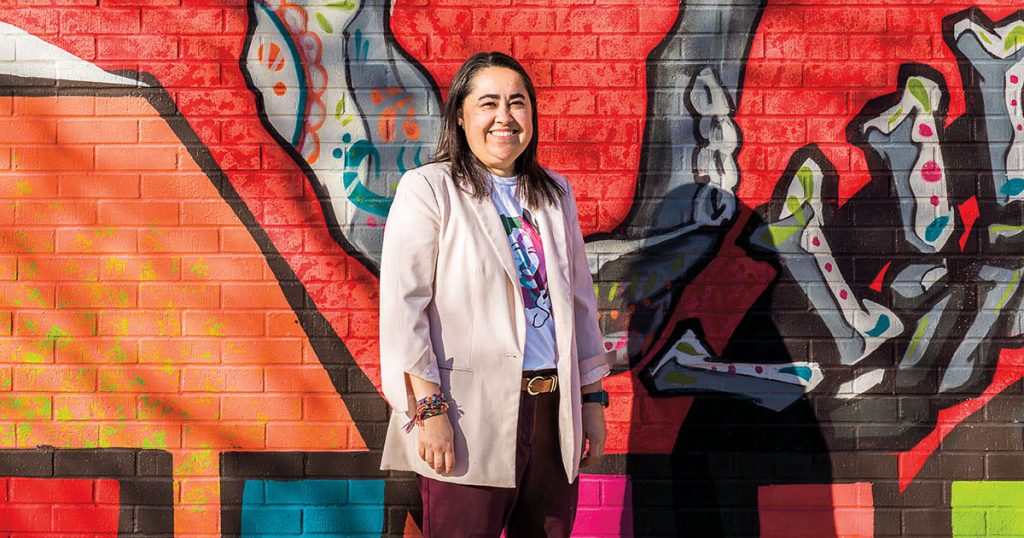
At the LBJ Ranch, working the phones the morning after the Democratic National Convention in Chicago, August 28, 1968. Photo by Yoichi Okamoto, courtesy LBJ Library.
After a year of the ongoing pandemic and, more recently, the Great Texas Freeze, all Texans will welcome the colorful blooms of this wildflower season. Fittingly, an expansive biography about our state’s first lady of wildflowers, Lady Bird Johnson, is being published this month: Lady Bird Johnson: Hiding in Plain Sight by Julia Sweig, a nonresident senior research fellow at the Lyndon B. Johnson School of Public Affairs at the University of Texas. The book arrives in conjunction with a new podcast by Sweig titled In Plain Sight: Lady Bird Johnson. Together, these works cast Lady Bird in a different spotlight as “a canny political operator, an activist, and a woman who figured out how to navigate that company town [Washington, D.C.].”
In Hiding in Plain Sight, Sweig vividly depicts a multidimensional portrait of Lady Bird that goes far beyond her image as a genteel Texas socialite and champion of flowers. For this comprehensive biography, the author drew substantially on 123 hours of audio diaries the first lady recorded during her White House years, much of which the general public has never heard before. In total, these diaries amount to a detailed account of 1,000 days in the White House, all told in Lady Bird’s hypnotic Southern drawl.
The abundance of rich content allowed Sweig to simultaneously create and produce a companion podcast. The eight-part series largely features narration by Lady Bird that vividly illustrates her “political partnership” with her husband and how the powerful couple navigated his presidency and the chaotic era of the 1960s. These memorable audio diaries take listeners behind the scenes of Lady Bird’s time on the campaign trail and later her solo tour of the Southern states to promote the Civil Rights Act of 1964. Part radio drama, newsmagazine, and historical documentary, this compelling podcast will appeal to a broad range of listeners.
For both the biography and podcast, Sweig pored through these vast transcripts, allowing her to cast a wider net over the first lady’s life and experiences during these defining years. (Lady Bird authorized the release of the White House tapes in 1997, but the last of the diaries weren’t released until 2017.) Through a friend, Sweig heard about Lady Bird’s diaries and made a trip down to Austin from her hometown of Washington, D.C. resulting in her insightful new look at one of Texas’ most remarkable women.

Julia Sweig’s new biography of Lady Bird Johnson casts the first lady as a “canny political operator.” Photo courtesy Lady Bird Johnson: Hiding in Plain Sight.
Not surprisingly, many nuances and complexities of the first lady and her multiple initiatives emerge in these pages. For example, with the beautification of the green spaces and streets of Washington D.C., Sweig recounts an intricate portrait of the first lady and her agenda: “Lady Bird wanted to begin to show the public that beneath the surface of the beautification efforts she promoted were deeper, structural dimensions to the urban crisis that connected to housing, industrial pollution, race, and economic inequality. In the documentary [a special Thanksgiving segment for ABC in 1966], she highlights the environmental threats to the rivers and public spaces specifically in Washington, D.C., and the squalid conditions in the built environment experienced by the most underserved of the city’s majority-black residents.”
Later in the book, Sweig writes of Lady Bird’s thoughts on her environmental efforts: “‘I’ll never forgive Lyndon’s boys for turning my environmental agenda into a beautification project. But I went ahead and talked about the wildflowers so as not to scare anybody, because I knew if people came to love wildflowers they’d eventually care about the land that grew ’em.’”
In October 1965, when Johnson underwent gallbladder surgery, the reader is given an intimate window into his two-week stay at the hospital. Sweig writes of Lady Bird’s role during this time of convalescence: “Although the president and First Lady stayed in the hospital for nearly two weeks during his recovery from the gallbladder surgery, Lady Bird returned to the White House for a few hours each day to ‘see what the outside world was doing.’ With such a long convalescence for what has since become outpatient surgery, Lyndon transformed his hospital suite into a West Wing of sorts. From his hospital bed, he signed thirteen domestic policy bills. Sometimes, as he recuperated, Bird sat beside him simply to hold his hand; other times, she retreated to her room to catch up on episodes of Gunsmoke recorded for her by the White House techies of the era.”
Sweig’s biography and podcast give readers and listeners a new understanding of Lady Bird and all that she did for her husband—and our country—as she filled out the picture of a monumental period in our history. Both are enlightening testaments to the fact that Lady Bird brought us not just wildflowers, but so much more.








